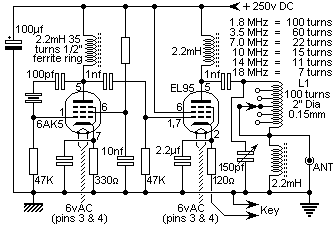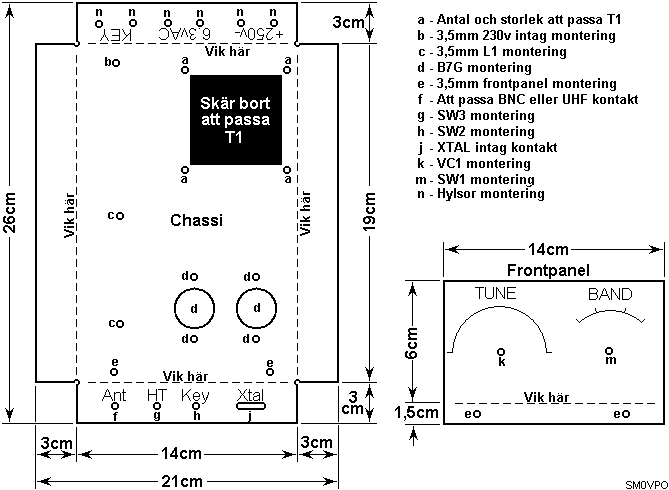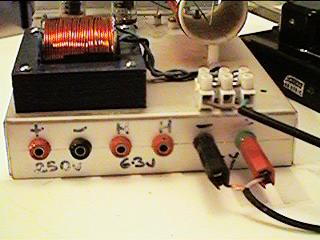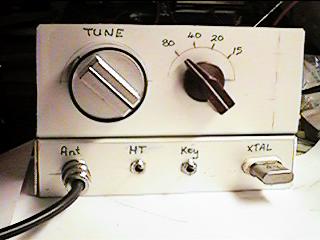

This transmitter is very stable and will deliver up to seven watts of power with the components and tubes shown. Do not be put-off by valves as they are VERY easy to work with and it seems that there are quite a few valves around. Because no-one wants these obsolete things they may be bought for next to nothing at radio rally's. If you are not too particular what type of valve you want then there are lots of valves available.

Above is the circuit of the transmitter including the coil winding information. The oscillator is a simple untuned Pierce oscillator which will oscillate at the fundamental frequency of the crystal. A 25pf variable capacitor between the grid of the first valve and earth will allow the final frequency to be "pulled" a little but I never used this facility.
The RF choke in the anode of the two valves is made up of 34 turns of enamelled wire wound on a 1/2" ferrite ring (2.2mH). The output tank circuit is wound on a piece of 2" dia plastic conduit tube. The object is to have as many turns of wire in circuit as it is possible to have on the band of interest. The output tuning capacitor should normally be set to about 10% when selecting the tapping for any particular band.
The cathode resistor and 2.2uf capacitor give quite a nice keying envelope to the keyed output. When the key is UP (off) there is about 100 volts DC across the 2.2uf so this component must be rated in excess of 100v. Because of the high voltage you should NOT use a CMOS keyer circuit without suitable buffering. I obtained my 2.2uf capacitor from an old telephone because they nearly always have a 2.2uf 250v non-electrolytic capacitor somewhere in the circuit.

The chassis is built using aluminium plate, drilled as shown above. An extra hole must be added to pass the connection from the PA anode to the tuning coil. If this connection is made using the output coupling capacitor under the chassis then there will be no high DC voltages above the chassis. The mains input terminals must be suitably protected to prevent contact with the mains input. Here is the rear panel of the transmitter. I also mounted sockets for connection to the PSU so that the finished transmitter is also a high voltage PSU for other projects.

The front panel is very uncluttered having only two controls; BAND switch and TUNE. I also added two switches, one to switch on the PSU HT and the other to key the TX for tuning purposes.

The oscillator is un-tuned so the only tuning procedure required is to select the band (coil tapping) and peak it for maximum RF output. The valves used were selected because they had B7G bases and were the first I put my hand on when I reached into my junk-box. Virtually any pentode valves will work in this application. An EL84, for example, will deliver over ten watts in this circuit but the valves quoted will deliver seven watts from 3.5 to 30 MHz. If you should use another tube then don't forget to check the screen voltage. If it is less than 250v then you will need a resistor in the screen supply to the valve.

The output tank coil should be built as shown. I only needed 40 turns on this one but on an earlier version I used a slightly smaller diameter tube and needed 58 turns (3.5MHz). Leave space for 65 turns (3.5MHz) then remove turns to achieve the lowest frequency you want to use. Adjust the tappings so that you achieve full power on each band with only 10% of the tuning capacitance in circuit. The coil can be easily tapped by masking adjacent turns with tape then scraping and soldering as shown in the photograph. If you want to add more turns to support the 1.8MHz band then you could either use the full 100 turns or add another (smaller) coil in series with the main coil.
Have fun, de HARRY, Lunda, Sweden.